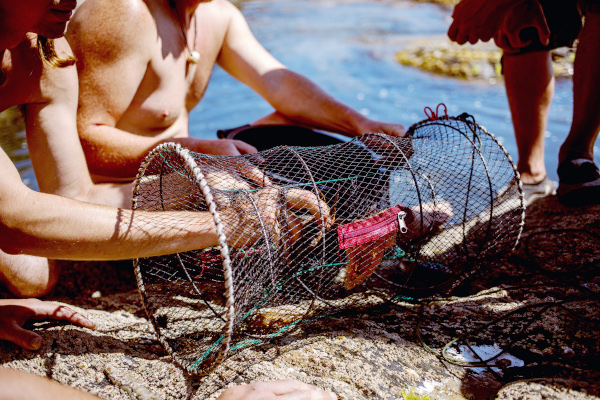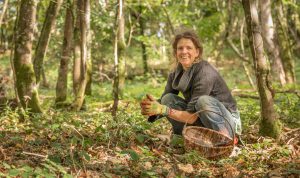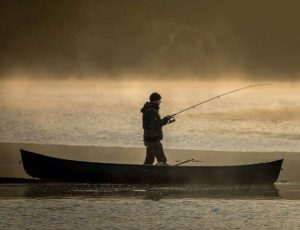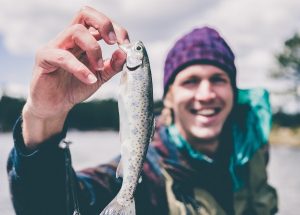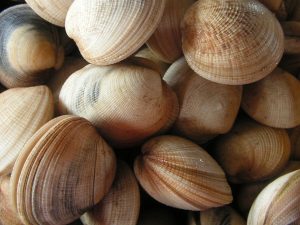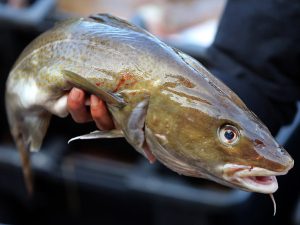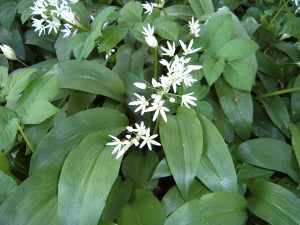Ever fancied fishing for your supper but don’t know where to begin? In Part 3 of her Fishing for Food series, Jessie Watson Brown explores fishing with lobster pots. Possibly a more efficient approach to fishing – once you have put the pot in, it does the fishing for you, leaving you free for a whole tide cycle to do anything else!
Many of us may remember paddling about in rock pools as a child, poking under rocks for crabs and fishing about with nets. This inter-tidal zone of rocks and pools, gulleys and seaweed, all exposed at low-tide, is an abundant landscape. The edge place where sea meets land, many creatures live in this rich habitat. If we want to find our food in the sea, this is a great place to go. As well as all the seaweed to harvest, and hopefully some winkles and mussels, there are potentially larger catches for the more adventurous coastal forager.
These larger creatures, such as lobsters, crabs and even fish, are slightly harder to catch than a rather sedentary winkle… so we generally need something to help us! One effective way to bridge the seashore and our plates is to use lobster pots.
So what are these and how do I use them?
A lobster pot is essentially a net trap. It is an open structure covered in netting. There are normally two entrances, that let creatures in, and due to their clever design, they can’t get out. You bait the pot, then leave it in the water for a tide cycle (until the next low tide, or two low tides), in which time some creatures will have hopefully entered the pot and you would have a ‘catch’.

Launching a pot out from the rocks, notice the long length of strong rope. Credit: Old Way
What equipment will I need?
You want to buy yourself a small collapsible pot – or a few – and some good strong string like paracord. The string is important to tie the pot to the rocks. The tiny string they come with isn’t strong enough and could snap while the tide is washing it about under water. If the pot comes loose, it could stay on the ocean and become a ‘ghost’ pot – one that continues to catch animals, with no way of retrieving it – that’s not something we want.
You may see larger, more sturdy looking pots. These are generally dropped from boats out at sea with a buoy marker. They aren’t that easy to carry down the beach and are much more expensive.

A collapsible lobster pot packs down small and is light enough to carry to those harder to reach beaches. Pic: Raj/Old Way
Then you might want a bucket or net bag to collect your catch in and take it home. And something to dispatch the fish and crustaceans with (I take a knife and a screwdriver).
How do I bait the pots?
There is a little bag inside the pot – add a mackerel head, or some old fishy bits like guts. Something a bit smelly works well!
Where is it best to set them?
This is really important – learn to read the shoreline. It’s best to set the pots in a rocky area extending out to sea. You must head out as the tide is going out – so you get there just before low tide. Look for gulleys or pools that are still underwater at low tide – and then find a good bit of rock to tie the pots to. This rope must be really secure, so something like a hole through the rocks is great, or even an outcrop with a narrow base.

The perfect location for some lobster pots, rocks exposed at low tide with plenty of handy places to tie to. Credit: Raj/Old Way
What should I be aware of?
Keep aware of your own safety. You will be scrambling over slippery rocks, often carrying awkward gear, so always be careful and wear sensible footwear. Let someone know where you have gone and when you will be back, and ideally take a friend!
Make sure you don’t get cut off as the tide comes in, get there with plenty of time.
You must also be really careful to remember where you set your pots – where you have tied them to the rocks. It can be a good idea to line up the spot with some markers on the land. Choose immovable and noticeable points and check they line up. So for example, maybe there is a cottage on the cliffs, and when you stand where you tied your pot it is in line with a particularly tall tree, remember this for when you go to check. It’s important not to leave pots unchecked for too long.

A spider crab can be a daunting sight in a pot, but once turned upside-down, they become docile and easier to handle. Pic: Old Way
What might I catch in my pot?
I always have so much excitement when I go to pull pots up… what surprises might be waiting for me?
You can end up catching all sorts of things in your pot. Of course, as the name suggests, you might catch lobsters, or crabs as well. You might also find fish and prawns in your traps too, as well as eels and dogfish (small sharks!).
Make sure you comply with minimum landing sizes, and any other seasonal or location-specific rules. A great book to take with you – with all this information and great pictures – is Edible Seashore by John Wright.
If a female has eggs, or ‘roe’, leave her in the sea to hatch her offspring. These look like lots of tiny eggs, found on her under side, under a triangular flap of shell. If a lobster has a ‘v’ notch in it’s tail it has been marked by commercial fishermen as a good breeder and should be left.

It can be useful to have a bucket to store your catch, just fill with seawater and some seaweed for short-term storage. Credit: Raj/ Old Way
Getting your catch out of the pot can be tricky, crabs might cling to the netting with their claws, or lobsters might aim for a final defence against you with their pincers. Be aware of getting your fingers caught. This part is really best done with someone who has some experience or knows how to handle crustaceans. A crab clinging to the side can best be dislodged with a firm tap to the claw, which will cause it to let go.
Anything you are planning on keeping to eat, you need to know how to kill. Again, it’s best to have someone around who knows what they are doing in order to do this properly. There are many ways to do this; some choose to kill crustaceans down by the shore, while others keep them in seawater and throw them in a boiling pot of water alive (like in a restaurant). There are numerous debates about which is most ‘humane’ or kind, but I leave it up to each individual to decide how to do it.
Should I be worried about fish stocks and populations?
Yes, of course it’s a major issue in our oceans today, though around the British shoreline fish numbers are remaining fairly abundant. I’ve even heard there are more lobsters in some areas than previous years. Still, definitely don’t take what you won’t eat – you can release what you don’t want fairly easily out of the trap and back into the sea.

Some of the delicious and nutritious food you might be able to gather in your lobster pot. Credit: Raj/Old Way
Due to the relatively low-impact nature of this type of fishing, compared to larger fishing boats or trawlers, this feels like a really sustainable way to catch and eat nutritious protein from the sea. Of course it is a personal choice whether we choose to eat fish, or any animal products at all.
With thanks to Charlie Loram and Robin Bowman of The Old Way for information.
 About the author
About the author
Jessie Watson Brown is a traditional tanner and basket weaver, making and crafting using natural materials. Jessie is based on Dartmoor, and offers courses and camps in tanning at Oak and Smoke Tannery. She looks after the Nature section of our website.

